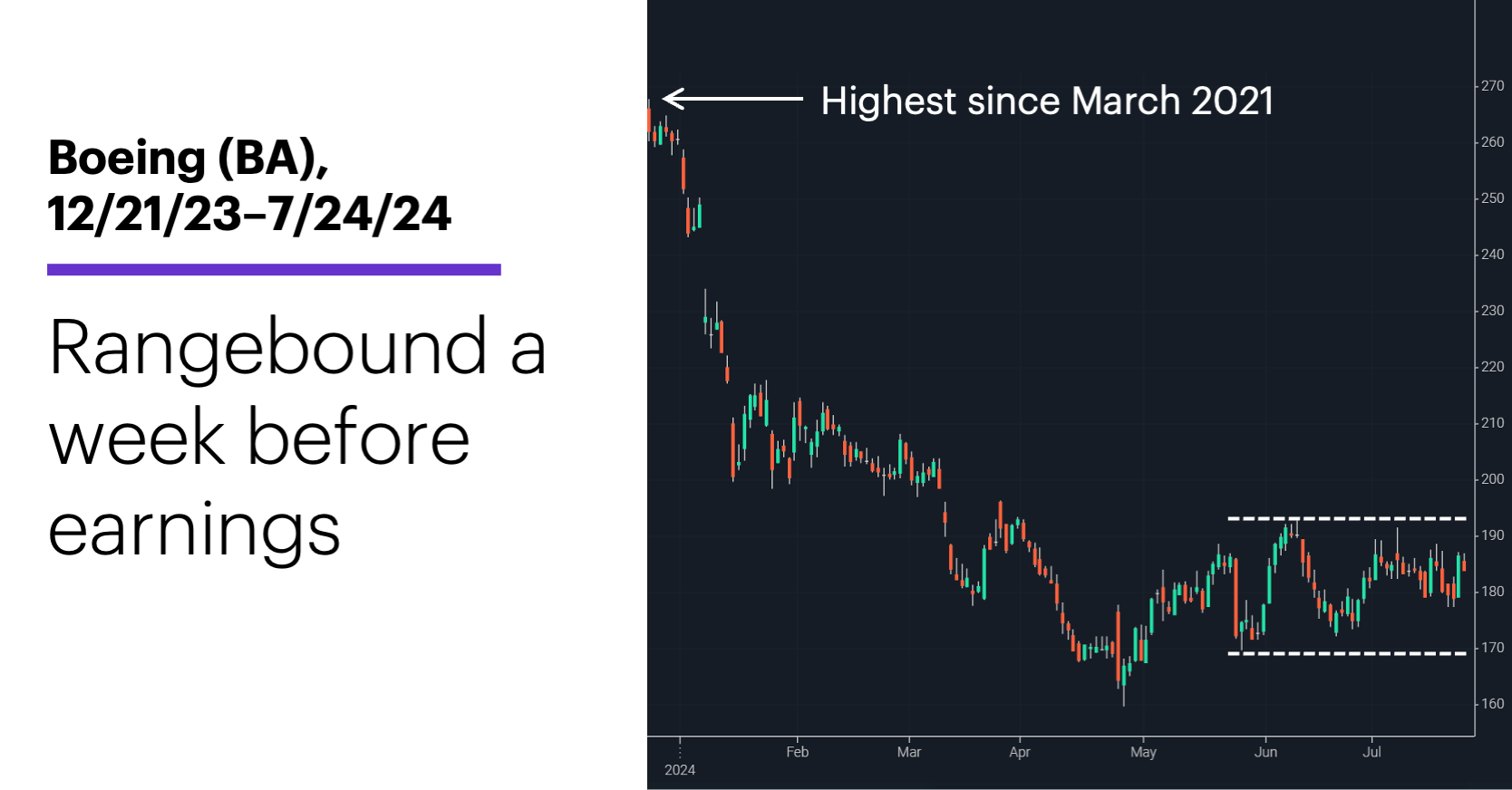Getting your hands around a strangle
- BA in a multi-month trading range after correction
- Short strangles and straddles profitable in recent weeks
- Upcoming earnings present “short volatility” risk
Option strategies like strangles and straddles sometimes entice traders because of their potential to profit regardless of the underlying stock’s direction—or lack thereof. Rangebound stocks, for instance, can appear to be ideal candidates for taking the short side of these strategies, since short options benefit from sideways price action and declining volatility (as well as time decay).
Of course, that’s likely to be true only if the stock continues moving sideways. But as is the case with trends, it’s impossible to know when a trading range will end.
Boeing’s (BA) recent price action illustrates how these risks and rewards can play out in the real world. Since falling nearly $100 between December and April, BA has mostly consolidated, trading between $169-$193 since late May:

Source: Power E*TRADE (For illustration purposes. Not a recommendation.)
This environment has, in fact, been good to short straddles and strangles. For example, on June 11 (a day BA closed at $185.50) a trader could have shorted a July 26 $170-$200 straddle (selling both the $170 put and the $200 call) for 5.26 ($526). The stock has remained between the two strike prices, and on Wednesday, both options were trading around 0.05, representing a $516 profit on the short straddle.
Now let’s assume a trader who only recently became aware of BA’s consolidation decided to execute a short strangle on Wednesday. The stock opened at $185.61—almost exactly where it was on June 11—so the trader shorted the August 9 $170-$200 strangle, collecting a total of 3.12 ($312) for selling the $170 put and the $200 call. If the stock remains between the two strike prices, both options will eventually expire worthless and the trader will keep all of the collected premium. Since BA hadn’t closed below $170 since April 30 or above $200 since March 7, it may have looked like a reasonable trade.1
Possibly, but that assumes continued low volatility and sideways price action. Now, however, there’s an important detail that wasn’t in play six to eight weeks ago: BA’s July 31 earnings release. To see how BA has performed in the past at the same point in time, the following table shows BA’s maximum price swings, up or down, for three periods: the four days before earnings, the six days after that (including earnings day), and the combined 10-day period:2

Source (data): Power E*TRADE (For illustration purposes. Not a recommendation.)
For perspective, the short strangle’s respective strike prices were 7.6% above and 8.4% below the stock price at the time of execution Wednesday morning ($185.61). This table suggests BA has a fair chance of trading that much higher or lower over the next 10 days—that is, pushing near or beyond the strangle’s strike prices and producing a losing trade: BA’s average maximum price swing over the entire 10-day period is +/-7.9%, and its biggest was -21.9%. In fact, the stock traded +/-7.9% or more during this period 22 out of 55 times.
Given this history, our trader may decide the strangle is still appropriate, that selecting more-distant strike prices is called for, or that the trade should be cancelled entirely. The key point is short strangles and straddles are “short volatility” trades that benefit from stable or declining volatility. They have unique risks in situations where volatility has the potential to increase sharply.
Today’s numbers include (all times ET): Q2 GDP, initial estimate (8:30 a.m.), Durable Goods Orders (8:30 a.m.), advance international trade in goods (8:30 a.m.), weekly jobless claims (8:30 a.m.), advance retail and wholesale inventories (8:30 a.m.), EIA Natural Gas Report (10:30 a.m.).
Today’s earnings include: American Airlines (AAL), AbbVie (ABBV), Dover (DOV), Honeywell (HON), Keurig Dr. Pepper (KDP), Southwest Airlines (LUV), Northrop Grumman (NOC), RPM (RPM), Verisign (VRSN).
Click here to log on to your account or learn more about E*TRADE's trading platforms, or follow the Company on Twitter, @ETRADE, for useful trading and investing insights.
1 In practice, the premium collected from the short strangle provides a buffer in the event of a move beyond one of the strike prices. In this example, the strangle has the potential to generate some profit if the stock closes at expiration above 166.88 (the put strike price minus the premium) or below $173.12 (the strike price plus the premium). Maximum profit is achieved only when both options expire worthless.
2 “Maximum price swing” for each period refers to the larger absolute value of: 1) the percentage difference between the closing price immediately preceding the period and the highest high of that period, or 2) the percentage difference between the closing price immediately preceding the period and the lowest low of that period. Supporting document available upon request.